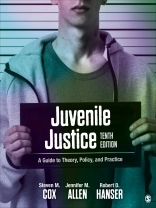Comprehensive, focused, and up-to-date,
Juvenile Justice: A Guide to Theory, Policy, and Practice, Tenth Edition illustrates the practical realities of the juvenile justice system and the most current topics in the field. Students will learn about the history, process, and theories of the juvenile justice system, and gain access to the latest crime measurements while exploring important issues like community-based sanctions, treatment and rehabilitation, gangs, and international youth crime. Emphasizing evidence-based practices, bestselling authors Steven M. Cox, Jennifer M. Allen, and Robert D. Hanser guide readers through the methods and problems of the system and offer realistic insights for students interested in a career in juvenile justice.
This title is accompanied by a complete teaching and learning package.
สารบัญ
Chapter 1. Juvenile Justice in Historical Perspective
Juvenile Justice Historically
Due Process and the Juvenile Justice System
Continuing Dilemmas in Juvenile Justice
Rethinking Juvenile Justice
Chapter 2. Characteristics, Definitions, and Measurement of Juvenile Offenders and Offenses
Delinquency Profiles
Social Factors
Physical Factors
The Intersectionality of Age, Gender, Race, and Social Class
Legal Definitions
Behavioral Definitions
Official Statistics: Sources and Problems
Official Statistics on Abuse and Neglect
Chapter 3. Child Abuse and Neglect
Domestic or Family Violence
Child Maltreatment
Types of Abuse and Neglect
Internet Exploitation
Intervention
Chapter 4. Schools and Delinquency
Protective Factors to Delinquency in School Environments
Risk Factors to Delinquency in School Environments
School Safety
Truancy
School Programs to Prevent or Deter Youth From Delinquency
Chapter 5. Theories of Causation
Scientific Theory
Some Early Theories
Biological Theories
Biosocial/Neurological Theory
Prenatal and Neonatal Development and Delinquency
Psychological Theories
Sociological Theories
Integrated Theories
Chapter 6. Juveniles and the Police
Police Discretion in Encounters With Juveniles
Police Procedures
Training and Competence of Juvenile Officers
Police–School Resource Officer and Liaison Programs
Community-Oriented Policing and Juveniles
Chapter 7. The Purpose and Scope of Juvenile Courts
Purpose
Comparison of Adult Criminal Justice and Juvenile Justice Systems
How the Juvenile Court Accomplishes the Purpose
Concepts Included in the Scope of Juvenile Court Acts
Chapter 8. Juvenile Justice Procedures
Rights of Juveniles at Various Stages in Juvenile Court
Understanding Bail and Taking Youth Into Custody by the Police
Juvenile Court Proceedings
Detention or Shelter Care
Chapter 9. Key Figures in Juvenile Court Proceedings
Roles of the Prosecutor and Defense Counsel
Relationship Between the Prosecutor and the Defense Counsel: Adversarial or Cooperative?
Judges and Probation Officers in Juvenile Court
Role of Children and Family Services Personnel, Victim Advocates, and Court Appointed Special Advocates in Juvenile Court
Training and Competence of Juvenile Court Personnel
Chapter 10. Prevention and Diversion Programs
Prevention and Diversion
Diversion Programs
Examples of Prevention and Diversion Programs
Some Criticisms
Chapter 11. Treatment Programming and Trauma-Informed Care With Juvenile Offenders
Mental Health Needs of Juvenile Offenders
Family-of-Origin Issues
Therapeutic Courts
Types of Treatment Modalities
Trauma-Informed Care
Sexuality, Sex Counseling, and Juvenile Sex Offender Treatment
Chapter 12. Dispositional Alternatives
Dispositional Alternatives—Probation, Restorative Justice, Foster Homes, and Treatment Centers
Juvenile Corrections—Dilemmas and Consequences
Capital Punishment and Youthful Offenders
Possible Solutions
Chapter 13. Violent Juveniles and Gangs
Juvenile Violence and Juvenile Homicide
Gangs
Brief History of Gangs
Theoretical Perspectives on Gang Development
Gang Membership
Risk Factors to Delinquency in School Environments
Characteristics of Gang Members
Female Juveniles and Gang Membership
Response of Justice Network to Gangs
Public, Legislative, and Judicial Reaction
Alternatives to Incarceration for Violent Juveniles
Chapter 14. Global Issues in Juvenile Justice
Age of Responsibility
Juvenile Detention Rates Around the World
Juvenile Exploitation and Delinquency
Internal Administration of Juvenile Justice
Use of Restorative Justice With Young Offenders Around the World
Chapter 15. The Future of Juvenile Justice
Possibilities for the Future of Juvenile Justice
Utilizing and Addressing Advances in Technology
Barriers to Change in Juvenile Justice
Private Juvenile Detention Facilities
Improvements to the Juvenile Justice System
เกี่ยวกับผู้แต่ง
John J.Conrad served as chair of the Department of Law Enforcement and Justice Administration at Western Illinois University and was very active in the department, university, and surrounding community. After teaching for more than 30 years, he is now retired and enjoying his time traveling throughout the United States.












